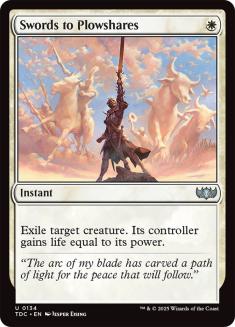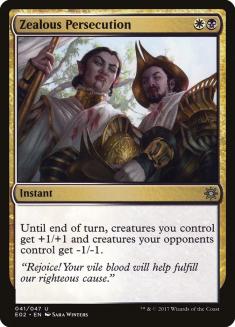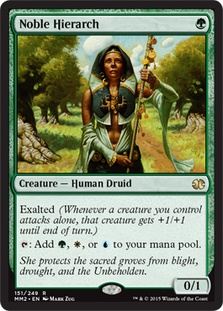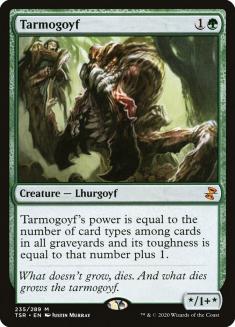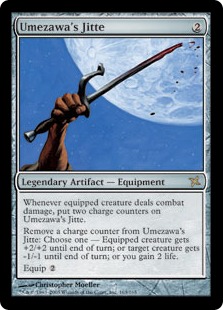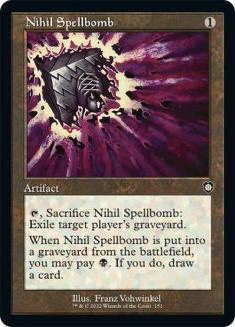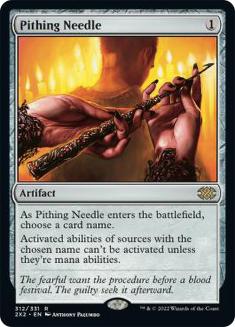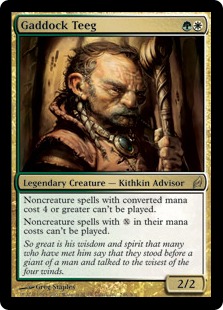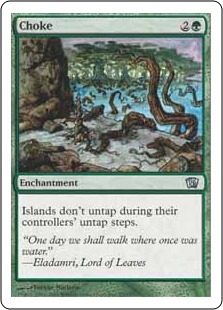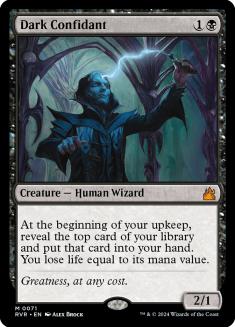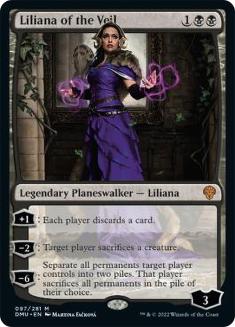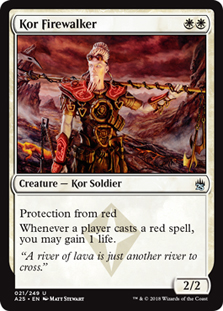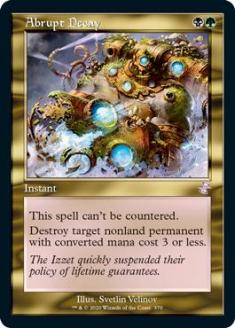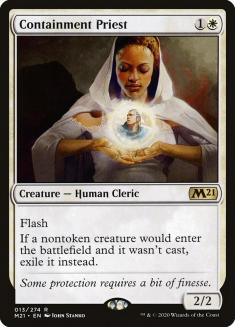Since the SCG Players’ Championship, things have been pretty slow for me with Magic. Between the holidays and getting back to work, I didn’t spend much
time playing in many high profile tournaments. Instead, I spent most of my time drafting the holiday cube on Magic Online and testing Legacy in preparation
for Open Series in Philadelphia this weekend. While testing for the Players’ Championship, I spent a good amount of time on two decks: Sultai Control,
which I will be playing this weekend, and Abzan Midrange, which my friend Ted will be piloting. I believe both decks are very solid off the radar decks
that fit my playstyle very well. I managed to put up a solid showing at the Players’ Championship with Sultai Control, as it originally was built by me and
Reid Duke as a pure metagame type deck.
Creatures (10)
Planeswalkers (3)
Lands (20)
Spells (27)

I originally wanted to go with Abzan Midrange, as I felt the deck was well-positioned, but it faced too many problems in the initial phase of testing, and
I didn’t have the time to put in the work to fix those problems. Problematic questions came up such as, how would I combat my opponent’s card drawing
spells and what would be my source of card advantage to be able to match theirs? I decided that the best way to combat Treasure Cruise and Brainstorm was
with Chains of Mephistopheles, while the best way to gain card advantage myself would be from Stoneforge Mystic and Dark Confidant. In the testing games
where I was able stick a Dark Confidant or multiple Stoneforge Mystics, I was able to keep up with my opponent’s card draw, while the games where I landed
Chains of Mephistopheles I was able to prevent them from developing their card drawing plan.
However, the other games were extremely difficult to play and many of the games were uphill battles. My original list also felt a bit clunky, as I was
getting jammed up with multiple three-drops in my hand. I quickly noticed was how unimpressive Knight of the Reliquary was, how slow Vindicate was, and
then quickly realized that I needed to lower the overall mana curve of the deck. Another thing I realized was how powerful Lingering Souls is in many fair
matchups; I knew I wanted more of them. Other than that, I felt the main draw to the deck was having very good sideboard options for the current metagame.
After more and more testing, the list I was most happy with was this.
Creatures (17)
Planeswalkers (2)
Lands (22)
Spells (19)

This list has the tools to be able to match up positively against many of the popular decks in the metagame, so let’s take a look at some of the matchups
you will be most likely to face.
VS Miracles
I’ll start with this deck because this is the deck I have the most experience against. In preparation for the Players’ Championship, I tested heavily
against Reid Duke and Kyle Shane who are two very good Miracles players. As many of you know, when playing against Miracles with most decks, the smallest
mistake can cost you a game, and in this matchup, this very much holds true because of how close it is.
On a positive note, you do have a handful of tools that match up very well against their plan, but on the opposite end of the spectrum, you also have many
that don’t. Out of your seventeen creatures, just about half of them are the cards you want to see in any given game against Miracles, while the other half
you can take or leave.
Dark Confidant and Stoneforge Mystic are the exact threats you want against them, as both provide card advantage. An unanswered Dark Confidant can go a
long way against them, chipping away at their life total while getting card advantage. Stoneforge Mystic will search up a Sword of Fire and Ice that will
turn any of your creatures into must-answer threats. In this matchup, it’s really important to not get blown out by Terminus, which means you never really
want to overextend on the board. This means Deathrite Shaman and Tarmogoyf are fine against them, but since neither provide any type of card advantage,
they are less important than your other creatures.
As far as your spells are concerned, Thoughtseize and Abrupt Decay are the cards you want to see in your opening hand. Thoughtseize should be able to clear
a path for either a Stoneforge Mystic or Dark Confidant, which will make the game much easier to navigate, while Abrupt Decay is strictly there to ensure
that Counterbalance never really gets online. Lingering Souls is also nice since Swords to Plowshares matches up very poorly against it. Besides the cards
I mentioned above, Chains of Mephistopheles and Liliana of the Veil are two of your biggest threats against them. Liliana of the Veil is fantastic since
they won’t have many answers for it once it’s in play. Chains is also good against them, but not nearly as good as Liliana is, since they normally run Dig
Through Time over Treasure Cruise. That means Chains has no effect there. It does, however, have some impact against their Brainstorms, Ponders, Tops, and
Jaces.
The poor cards to draw in game 1 aren’t plentiful, but you pretty much never want to see any Swords to Plowshares or Zealous Persecutions. However, after
game 1 you really get to sculpt your deck for the matchup, and your weaker cards will be turned into very powerful ones. Sideboarding is as followed.
Out:
In:
Your sideboard cards are very good against them, and each plays a very important role in stopping their gameplan. Pithing Needle will almost always name
Sensei’s Diving Top, but it can also be used against Jace, the Mind Sculptor or even a fetchland. Nihil Spellbomb will try and keep their Dig Through Times
in check at a reasonably low cost. Some players may also have Snapcaster Mage, so there is another advantage to boarding in the Spellbombs. Gaddock Teeg
will be annoying for them, as they will have to answer it before they can really get going. Finally, you have your two biggest weapons against them in
Choke and Armageddon. Miracles normally needs a lot of mana to develop their gameplan, and both of these do a great job on damaging their development.
Overall, this is a very fair matchup, and tight play along with solid sideboarding will take you a long way.
VS U/R Delver
This deck is next on the list since it is most likely going to be the most popular deck in the room. The deck plays out very smoothly and has excellent
sources of card advantage in Young Pyromancer and Treasure Cruise. However, your matchup against this deck is a very good one. Chains of Mephistopheles,
Swords to Plowshares, Abrupt Decay, Zealous Persecution, Tarmogoyf, Batterskull, and Sword of Fire and Ice are all cards they don’t want to see, and that’s
just for game 1! After board, your matchup gets even better as you will have even more hard to deal with cards for them.
Your basic gameplan game 1 against them is to quickly stick either a Tarmogoyf or Stoneforge Mystic, then search up one of your powerful pieces of
equipment. Another good plan is to keep them from playing their game by landing a Chains of Mephistopheles. Once the Chain resolves, a healthy amount of
their deck will become pretty much useless, and from there you should be in good shape as long as you are at a reasonable life total and not too far behind
on the board.
Out:
In:
With these upgrades that you get to make after board, your matchup should go from good to great. Just remember to try and not play around anything
for the most part, as it is likely they will side out their Force of Wills and possibly Dazes. In a matchup like this, it is normally better to just run
out what you have since many of your threats are redundant and you have a lot of them.
VS Stoneforge Mystic Decks
All of these matchups normally play out similarly and all have a pretty similar core to the deck, so I’ve lumped them altogether. Each matchup is fairly
close, and the sideboard suggestions that I give will normally overlap but will have to be slightly adjusted in each matchup. I’m a big fan of not having
an exact sideboard plan against these decks, but I know players who really love certain cards against these decks, so it just depends on the type of player
you are. Regardless, when playing against any of these decks in game 1, your plan should almost always be the same. You are basically looking to get down a
few threats while keeping your opponents side of the board clear with the help of your discard and removal spells. You can expect the game to go long, and
you can expect Chains of Mephistopheles to play a big role. If they pull too far ahead on cards, it will be very difficult for you to win, so make sure you
try to find a clear path for it to resolve. With that said, your Thoughtseizes should often try to snag a Treasure Cruise or Dig Through Time unless there
is something else you think you should really take. For example, when you Thoughtseize your opponent on the play on turn 1 and you see three lands, Swords
to Plowshares, Treasure Cruise, Stoneforge Mystic, and Young Pyromancer, if you have a Dark Confidant in hand, I would suggest taking the Swords so you can
start to build up a few extra cards, especially if you have your own removal spell for one of their two-drops. Remember: the more you play these types of
matchups, the easier they will become since experience plays an important role in Legacy, especially in the grindy matchups. Another thing to remember is
that your Wastelands will often be very good in these matchups and can be something you should use to your advantage.
Out:
Note: Taking out Dark Confidant largely depends on whether you’re on the play or draw. Zealous Persecution is also a keep if they have Young Pyromancer or
True-Name Nemesis. Adjust accordingly.
Again, Choke is a largely a play versus draw situation. Obviously, don’t bring in Kor Firewalker against Deathblade.
The sideboarding will shift between these decks depending on your opponent and their variant, but your gameplan should stay relatively the same. There will
most likely be many decisions on both sides, so make sure you take your time and look for the long-term advantage rather than trying to sneak in a few
points of damage here and there.
VS Sneak and Show/Reanimator
Both of these matchups play out fairly similarly, and both of these matchups are quite difficult. Reanimator isn’t as bad since you have both Deathrite
Shaman and Nihil Spellbomb to slow them down. However, against Sneak and Show, those cards don’t matter much. Instead you are heavily reliant on your four
copies of Thoughtseize to disrupt them. Your main plan should be to try and hit them with an early Thoughtseize and put as much pressure on them as
possible with either a Tarmogoyf or a Stoneforge Mystic that can fetch up a Sword of Fire and Ice. Both decks can be very fast, which means if you know the
matchup and your draw in game 1 doesn’t have the right tools, don’t be hesitant to mulligan very aggressively. Against both decks, Dark Confidant is very
good since taking the extra damage won’t matter much, and the extra cards you will get from Dark Confidant will be well worth it.
Out (VS Sneak and Show):
In (VS Sneak and Show):
Though we are boarding in nine cards, none of them besides Containment Priest are actually really great against them. Pithing Needle is likely to name
Sneak Attack or Griselbrand, which is fine, but they have many ways around it. For example, they can just Show and Tell in an Emrakul, the Aeons Torn
leaving you with only Liliana of the Veil as an out.
Something you might have noticed is that I decided to bring in one Choke in this matchup, as I don’t really like many copies here. I think it’s more likely
that you will get lucky with an Armageddon rather than trying to lock them down with a Choke. Most of their lands are not Islands, as they normally run
only two Islands and four Volcanic Islands, and they also have Lotus Petals. They’re also not really a deck that cares about Choke since they can also just
not play a spell until they have both their combo pieces and then go off in one turn. The Gaddock Teegs and the Nihil Spellbombs can be annoying for them,
but it’s nothing really too devastating.
As I mentioned early, you have to draw well, hope they stumble, and mulligan aggressively if need be. There are several ways to help out the matchup by
adding certain sideboard cards to your list, but it might not be worth it unless you think Sneak and Show will be very popular. I personally feel Sneak and
Show is a very hit or miss deck, as sometimes it’s super popular, and other times there are only a handful of players in the tournament that are running
it. Cards such as Humility, Ensnaring Bridge, Hymn to Tourach, Surgical Extraction, or additional copies of Karakas would help and should be something to
consider if you think this will be a big part of your metagame.
Out (VS Reanimator):
In (VS Reanimator):
As I stated earlier, this matchup is much better than Sneak and Show. Even though the overall gameplan on both sides are fairly similar, you are at least
able to hit their graveyard at a very cheap cost, and your other tools like Containment Priest will help out greatly. As far as the other two cards you are
bringing in, one is definitely useful (Pithing Needle), since it can help fight against Griselbrand and Ratchet Bomb (which they are likely to board in).
However, the other one (Gaddock Teeg) won’t really do much but is there to hedge against Force of Will.
As far as the other decks you might face in Legacy, the list can go on and on. Burn or the now rarely seen Goblins deck are both good matchups since you
have cheap efficient removal along with three pieces of equipment that can heavily push the game in your favor.
As far combo decks go, many of them are uphill battles, but some matchups (such as Elves) are actually a pretty good. Between Swords to Plowshares, Abrupt
Decay, Zealous Persecution, and sideboard cards like Containment Priest and Gaddock Teeg, you should have enough answers for whatever they try to throw at
you.
So now that I shared my thoughts on Abzan, what do you guys think? And what’s everyone playing this weekend? I’m sticking with Sultai Control, and I’m
expecting a lot of U/R Delver, Jeskai Stoneblade, and Miracles, so make sure those are the decks you have experience playing against.


